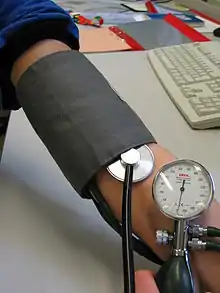Mean arterial pressure
In medicine, the mean arterial pressure (MAP) is an average blood pressure in an individual during a single cardiac cycle.[1] MAP is altered by cardiac output and systemic vascular resistance.[2]
| Mean arterial pressure | |
|---|---|
 Representation of the arterial pressure waveform over one cardiac cycle. The notch in the curve is associated with closing of the aortic valve. | |
| MeSH | D062186 |
Testing

Mean arterial pressure can be measured directly or determined by using a formula.[2] The least invasive method is the use of an blood pressure cuff which gives the values to calculate the mean pressure. A similar method is to use a oscillometric blood pressure device that works by a cuff only method where a microprocessor determines the systolic and diastolic blood pressure.[3] Invasively, an arterial catheter with a transducer is placed and the mean pressure is determined by the subsequent waveform.[4]
Calculation
While MAP can only be measured directly by invasive monitoring. The MAP can be estimated by using a formula in which the lower (diastolic) blood pressure is doubled and added to the higher (systolic) blood pressure and that composite sum then is divided by 3 to estimate MAP.[5]
Normal heart rate
The most common formula for calculating mean arterial pressure is:
where:
- DP = diastolic pressure
- SP = systolic pressure
- MAP = mean arterial pressure
Systolic pressure minus diastolic pressure equals the pulse pressure which may be substituted in.[2]

Another way to find the MAP is to use the Systemic Vascular Resistance equated (), which is represented mathematically by the formula
where is the change in pressure across the systemic circulation from its beginning to its end and is the flow through the vasculature (equal to cardiac output).
In other words:
Therefore, Mean arterial pressure can be determined by rearranging the equation to:
where:
- is cardiac output
- is systemic vascular resistance
- is central venous pressure and usually is small enough to be neglected in this formula.[7]
This is only valid at normal resting heart rates during which can be approximated using the measured systolic () and diastolic () blood pressures:[8][9][10]
Elevated heart rate
At high heart rates is more closely approximated by the arithmetic mean of systolic and diastolic pressures because of the change in shape of the arterial pressure pulse.
For a more accurate formula of for elevated heart rates use:
Where
- HR = heart rate.
- DP = diastolic pressure
- MAP = mean arterial pressure
- PP = pulse pressure which is systolic minus diastolic pressure[11]
Most accurate
The version of the MAP equation multiplying 0.412 by pulse pressure and adding diastolic blood is indicated to correlate better than other versions of the equation with left ventricular hypertrophy, carotid wall thickness and aortic stiffness.[12] It is expressed:
where:
- DBP = diastolic pressure
- MAP = mean arterial pressure
- PP = pulse pressure
Young Patients
For young patients with congenital heart disease a slight alteration to the factor used found to be more precise. This was written as:
where:
- DBP = diastolic pressure
- MAP = mean arterial pressure
- PP = pulse pressure
This added precision means cerebral blood flow can be more accurately maintained in uncontrolled hypertension.[13]
Neonates
For neonates, because of their altered physiology, a different formula has been proposed for a more precise reading:
where:
- DBP = diastolic pressure
- MAP = mean arterial pressure
- PP = pulse pressure
It has also been suggested that when getting readings from a neonates radial arterial line, mean arterial pressure can be approximated by averaging the systolic and diastolic pressure.[14]
Clinical significance
| 24 hr. MAP category | 24 hr. MAP |
|---|---|
| Normal | <90 mmHg |
| Elevated blood pressure | 90 to <92 mmHg |
| Stage 1 hypertension | 92 to <96 mmHg |
| Stage 2 hypertension | >96 mmHg |
Mean arterial pressure is considered to be the perfusion pressure seen by organs in the body. It is believed that a MAP that is greater than 70 mmHg is enough to sustain the organs of the average person. MAP is normally between 65 and 110 mmHg.[20]
Hypotension
In patients with sepsis, the vasopressor dosage may be titrated on the basis of estimated MAP.[5]
Even 1 minute at a mean arterial pressure of 50 mmHg, or accumulative effects over short periods, increases the risk of mortality by 5% and can result in organ failure or complications.[21][22] MAP may be used like systolic blood pressure in monitoring and treating target blood pressure. Both have been shown advantageous targets for sepsis, major trauma, stroke, intracranial bleed. If the MAP falls below the target number for an appreciable time, vital organs will not get enough oxygen perfusion, and will become hypoxic, a condition called ischemia.[23]
Hypertension
As the 24 hour mean arterial pressure increases, so does the risk of adverse cardiovascular events. MAP shows information about both the systolic and diastolic blood pressure In the management of high blood pressure, so it can be evaluated to ensure perfusion is maintained to the organs.[19]
References
- Zheng L, Sun Z, Li J, et al. (July 2008). "Pulse pressure and mean arterial pressure in relation to ischemic stroke among patients with uncontrolled hypertension in rural areas of China". Stroke. 39 (7): 1932–7. doi:10.1161/STROKEAHA.107.510677. PMID 18451345.
- DeMers, Daniel; Wachs, Daliah (2022), "Physiology, Mean Arterial Pressure", StatPearls, Treasure Island (FL): StatPearls Publishing, PMID 30855814, retrieved 2022-05-22
- Lewis, Philip S. (March 29, 2019). "Oscillometric measurement of blood pressure: a simplified explanation. A technical note on behalf of the British and Irish Hypertension Society". Journal of Human Hypertension. 33 (5): 349–351. doi:10.1038/s41371-019-0196-9. ISSN 1476-5527.
- "mean arterial pressure". www.ebi.ac.uk. Retrieved 2022-05-27.
- Calculating the mean arterial pressure (MAP) Nursing center2011-12-08
- Gauer (1960). Von Urban and Schwarzenberg (ed.). Kreislauf des Blutes. Lehrbuch der Physiologie des Menschen.
- Cardiovascular Physiology Concepts: Mean Arterial Pressure, Richard E. Klabunde, Ph.D
- Nosek, Thomas M. "Section 3/3ch7/s3ch7_4". Essentials of Human Physiology. Archived from the original on 2016-03-24.
- Cardiovascular Physiology (page 3) Archived 2006-12-11 at the Wayback Machine
- http://www.clinicalreview.com Physiology Review
- Moran D, Epstein Y, Keren G, Laor A, Sherez J, Shapiro Y (1995). "Calculation of mean arterial pressure during exercise as a function of heart rate". Applied Human Science. 14 (6): 293–5. doi:10.2114/ahs.14.293. PMID 8591100.
- Papaioannou, Theodore G.; Protogerou, Athanase D.; Vrachatis, Dimitrios; Konstantonis, Giorgos; Aissopou, Evaggelia; Argyris, Antonis; Nasothimiou, Efthimia; Gialafos, Elias J.; Karamanou, Marianna; Tousoulis, Dimitris; Sfikakis, Petros P. (May 19, 2016). "Mean arterial pressure values calculated using seven different methods and their associations with target organ deterioration in a single-center study of 1878 individuals". Hypertension Research. 39 (9): 640–647. doi:10.1038/hr.2016.41. ISSN 1348-4214.
- Meaney, Eduardo; Alva, Felix; Moguel, Rafael; Meaney, Alejandra; Alva, Juan; Webel, Richard (2000-07-01). "Formula and nomogram for the sphygmomanometric calculation of the mean arterial pressure". Heart. 84 (1): 64–64. doi:10.1136/heart.84.1.64. ISSN 1355-6037. PMID 10862592.
- Gevers, M.; Hack, W. W.; Ree, E. F.; Lafeber, H. N.; Westerhof, N. (1993). "Calculated mean arterial blood pressure in critically ill neonates". Basic Research in Cardiology. 88 (1): 80–85. doi:10.1007/BF00788533. ISSN 0300-8428. PMID 8471006.
- Chemla, Denis; Hébert, Jean-Louis; Zamani, Karen; Coimult, Catherine; Lecarpentier, Yves (1999-08-14). "Estimation of mean aortic pressure". The Lancet. 354 (9178): 596. doi:10.1016/S0140-6736(05)77948-4. ISSN 0140-6736. PMID 10470724.
- Razminia, Mansour; Trivedi, Atul; Molnar, Janos; Elbzour, Monther; Guerrero, Mayra; Salem, Yasser; Ahmed, Aziz; Khosla, Sandeep; Lubell, David L. (2004). "Validation of a new formula for mean arterial pressure calculation: The new formula is superior to the standard formula". Catheterization and Cardiovascular Interventions. 63 (4): 419–425. doi:10.1002/ccd.20217. ISSN 1522-1946.
- Chemla, Denis; Nitenberg, Alain (2005-06-01). "A Call for Improving Mean Aortic Pressure Estimation". American Journal of Hypertension. 18 (6): 891–891. doi:10.1016/j.amjhyper.2004.10.025. ISSN 0895-7061.
- CHEMLA, Denis; HÉBERT, Jean-Louis; APTECAR, Eduardo; MAZOIT, Jean-Xavier; ZAMANI, Karen; FRANK, Robert; FONTAINE, Guy; NITENBERG, Alain; LECARPENTIER, Yves (2002-06-24). "Empirical estimates of mean aortic pressure: advantages, drawbacks and implications for pressure redundancy". Clinical Science. 103 (1): 7–13. doi:10.1042/cs1030007. ISSN 0143-5221.
- Melgarejo, Jesus D.; Yang, Wen-Yi; Thijs, Lutgarde; Li, Yan; Asayama, Kei; Hansen, Tine W.; Wei, Fang-Fei; Kikuya, Masahiro; Ohkubo, Takayoshi; Dolan, Eamon; Stolarz-Skrzypek, Katarzyna (2021-01-01). "Association of Fatal and Nonfatal Cardiovascular Outcomes With 24-Hour Mean Arterial Pressure". Hypertension. 77 (1): 39–48. doi:10.1161/HYPERTENSIONAHA.120.14929.
- impactEDnurse (May 31, 2007). "mean arterial pressure". impactednurse.com. Archived from the original on December 12, 2013. Retrieved 2013-12-12.
- Nicklas, J.Y., Beckmann, D., Killat, J. et al. Continuous noninvasive arterial blood pressure monitoring using the vascular unloading technology during complex gastrointestinal endoscopy: a prospective observational study. 2019;33:(25).
- Maheshwari K., Khanna S., Bajracharya GR., et al. A Randomized Trial of Continuous Noninvasive Blood Pressure Monitoring During Noncardiac Surgery. Anesth Analg. 2018;127(2):424–431.
- Magder SA (2014). "The highs and lows of blood pressure: toward meaningful clinical targets in patients with shock". Crit. Care Med. 42 (5): 1241–51. doi:10.1097/ccm.0000000000000324. PMID 24736333. S2CID 39745357.